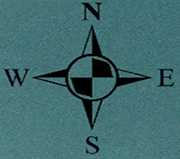Identifying Ships in the Archaeological Record
Plans of Grotto Bay Barges and their position within Grotto Bay (all images courtesy Program in Maritime Studies, ECU; Background images courtesy of Department of Conservations Services).
Positively identifying underwater vessels is difficult. Few sunken ships are found with nameplates or ships’ bells. Nevertheless matching details within historical sources to clues in the archaeological record is the best method for ship identification. Despite a researcher’s best efforts and intentions, some vessels may never be identified. For example, two barges in Grotto Bay may have been numbered rather than named, and the documents outlining these numbers may have disappeared or been destroyed. In other cases, historical descriptions of location and construction potentially aid in their identification. For example, the best fit for most of the debris at Site 1 at Meyer’s Wharf is currently the five-masted ship Fraternité, built in Tacoma (Washington State, USA), in 1918. The French owned schooner ran aground on the reef and was then towed to Meyer’s Wharf. The location, orientation, and artifacts correspond with the historical record. However, in the end, site identification is secondary to understanding research questions relating to ship breaking behavior in Bermuda.
Previous Next

